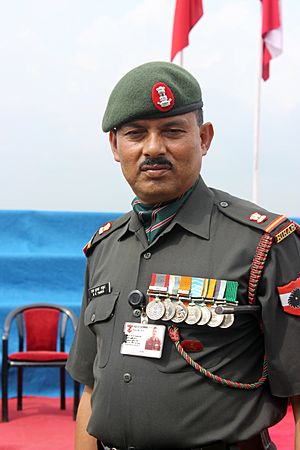Subedar-major facts for kids
A Subedar-major is a very important and senior rank in the armies of India and Pakistan. They are like the most experienced and respected non-officer leaders in the army. This rank used to be called a Viceroy's commissioned officer when India was under British rule.
Contents
A Look Back: History of the Subedar-major
Long ago, when India was ruled by the British (this time was called the British Raj), the Subedar-major was the highest rank a local Indian soldier could reach. This special position was created on October 28, 1817. It was started by the East India Company (EIC) in the Bengal Army. The Madras Army also began using this rank in 1819.
Later, in 1825, a similar rank called risaldar-major was created for cavalry units. Both Subedar-majors and Risaldar-majors acted as a link between Indian soldiers and British officers. They could also lead their own groups of soldiers.
Under British rule, a Subedar-major wore a special badge. It was a crown, similar to a British major. This tradition of wearing a special badge continues today, even after India and Pakistan became independent.
After Independence: The Role Today
After India and Pakistan became independent in 1947, the old British Indian Army was divided. Both new armies kept the important rank of Subedar-major.
In the Indian Army
In the Indian Army, a Subedar-major (often called SM) is a very experienced leader. They are junior to a commissioned officer like a Lieutenant. Soldiers often call them SM Sahab out of respect.
A Subedar-major can lead a group of soldiers or work at a military headquarters. Because of their great service, they are sometimes given honorary ranks. These can be Hon. Lieutenant or Hon. Captain. This shows how much their hard work is valued.
Today, Indian Army Subedar-majors wear a special badge. It shows the Ashoka lions (India's National Emblem) in gold. Below it, there is a red-gold-red stripe. This stripe helps tell them apart from full commissioned majors.
The Subedar-major is like the chief advisor to the commanding officer of a unit. They help by giving advice on important army matters. They report anything that affects the unit's safety, how it's run, or the soldiers' spirits.
They are also in charge of keeping everyone safe. This includes soldiers, civilians, and even visitors to the unit. The Subedar-major also makes sure that the unit's traditions and customs are followed. They help keep religious places within the battalion well-maintained.
This senior leader also handles all the money for the unit. They are responsible for the well-being of all junior officers and soldiers. A Subedar-major also guides young officers and new soldiers. They help keep the whole unit disciplined and working together.
In the Pakistan Army
The Pakistan Army also got its rank system from the British Empire. The Subedar-major is the highest rank for non-officer leaders in the Pakistan Army. It is similar to a NATO OR-9 rank. Their badge has a star and crescent with green and red colors. These stripes help tell them apart from full commissioned majors. This rank is also known as Risaldar-major.
A Battalion Subedar-major (BSM) is a specific role within a regiment. This person advises the unit's officers on matters related to the enlisted soldiers. They are also responsible for making sure enlisted soldiers follow the rules.
After Pakistan was created in 1947, this rank remained very important. The Subedar-major in a battalion acts as a voice for the enlisted soldiers. Officers often call senior enlisted ranks like Battalion Subedar-major 'Sahab' or 'Staff'. This shows their respect.
Military colleges in Pakistan also use the Battalion Subedar-major role. It is given to senior students as a special cadet appointment.




